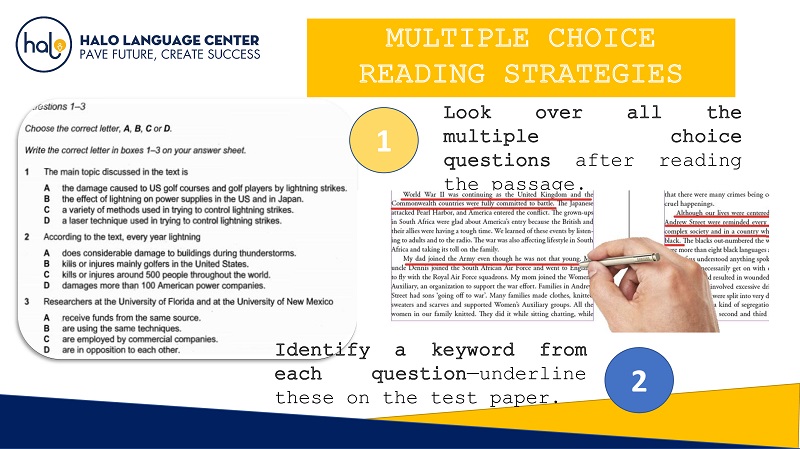
MULTIPLE CHOICE READING STRATEGIES
Step 1: Look over all the multiple choice questions after reading the passage.
Step 2: Identify a keyword from each question—underline these on the test paper.

Step 3: If you have time, identify a keyword from each answer choice.

MULTIPLE CHOICE HOW TO RECOGNIZE
There is a question or incomplete sentence, followed by three or more possible answers.
Most multiple choice questions have only three possible answers, but some will have four or five.
Usually, there is only one correct answer. Sometimes, you will be asked to select two correct answers.

SAMPLE TASK
THE ISLES OF SCILLY
1. The Isles of Scilly (pronounced SILL-ee) form an archipelago off the southwestern tip of Comwall. They are comprised of 140 islands and islets, the most significant of which are St Mary’s, Tresco, St Martin’s (with White Island), St Agnes (with Gugh), Bryher (with Gweai), Samson, Annet, St Helen’s, Tan and Great Gangly. The total population of the Isles of Scilly is just over two thousand. Scientific evidence suggests that the isles were likely much larger in ancient times and that many of them would have been joined into one island. Rising sea levels over time have led to the current geography.
2. Up until the early twentieth century, the residents of the Isles of Scilly practiced subsistence living, raising their own livestock and crops and catching fish to eat. Today, things are quite different. The Isles are well known for their flowers, particularly daffodils, which are their chief agricultural product. Otherwise, the Isles today depend largely on food and other products imported from the mainland, though fishing remains a popular pastime, if not a significant source of income.
3. The main industry on the isles today is tourism, making up 85% of the islands’ total income. The favorable summer climate, conducive to flowers and holidays, facilitate the large amount of tourism in the area. The bulk of tourists visit St Mary’s, the only island with a significant road network and airport, though the island of Tresco also has a number of timeshare resorts and a heliport. The holiday season on the Isles of Scilly, unlike many other tourist destinations in England, extends through October, when the isles are a top destination for bird watchers who come to see the many exotic birds who make the first stop of their migration on the isles.
4. The dominance of the tourism industry on the island has caused some political problems. Sixty-three percent of the island’s jobs come from the tourism industry, but the vast majority of these offer only seasonal or part-time work. Thus, the isles employ a number of guest workers. Currently, the average income on the islands is only 70% that of the national average in the UK, whereas housing prices are, on average E5,000 more expensive than in the rest of the country. These factors make life difficult for those who make the isles their home, though they continue to be very popular among tourists.
Questions 1-6
Choose the correct answer: A, B or C.
1. The geography of the Isles of Scilly was shaped by
A. changing sea levels.
B. a decline in farming.
C. a rise in population.
2. A political issue on the islands is that there are not enough
A. placets for islanders and tourists to live.
B. full-time, year-round jobs.
C. roads and shops to accommodate the seasonal visitors.
3. Today, the Isles of Scilly are renowned for producing and selling
A. fish.
B. livestock.
C. daffodils.
4. Houses in the Isles of Scilly are
A. cheaper than houses in England.
B. costlier than houses in the UK.
B. owned mostly by part-time residents.
5. A chief reason that tourists visit the Isles of Scilly is to see
A. the many airports and helicopters.
B. the historical church on the main island.
C. unusual birds that are passing through.
6. Which of the following is an appropriate title for the passage?
A. The Pros and Cons of Island Tourism
B. Reasons to Visit the Isles of Scilly
C. The Geography of a British Archipelago
D. Introducing the Isles of Scilly
E. Island Life Before and After Subsistence Living
